
Carmel-by-the-Sea, often simply called Carmel, is a city in Monterey County, California, United States, founded in 1902 and incorporated on October 31, 1916. Situated on the Monterey Peninsula, Carmel is known for its natural scenery and rich artistic history. In 1906, the San Francisco Call devoted a full page to the "artists, writers and poets at Carmel-by-the-Sea", and in 1910 it reported that 60 percent of Carmel's houses were built by citizens who were "devoting their lives to work connected to the aesthetic arts." Early City Councils were dominated by artists, and several of the city's mayors have been poets or actors, including Herbert Heron, founder of the Forest Theater, bohemian writer and actor Perry Newberry, and actor-director Clint Eastwood, who served as mayor from 1986 to 1988.

The Forest Theater is an historic amphitheater in Carmel-by-the-Sea, California. Founded in 1910, it is one of the oldest outdoor theaters west of the Rockies. Actor/director Herbert Heron is generally cited as the founder and driving force, and poet/novelist Mary Austin is often credited with suggesting the idea. As first envisioned, original works by California authors, children's theatre, and the plays of Shakespeare were the primary focus. Since its inception, a variety of artists and theatre groups have presented plays, pageants, musical offerings and other performances on the outdoor stage, and the facility's smaller indoor theatre and school.
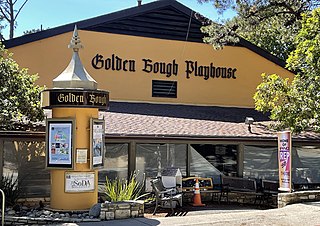
The Golden Bough Playhouse is a historic three-story theatre in Carmel-by-the-Sea, California on Monte Verde St., between 8th and 9th Avenues. The playhouse occupies the site of the former Carmel Arts and Crafts Club, Carmel's first cultural center and theatre, built in 1906–1907 on Casanova Street, and the Arts and Crafts Hall, built in 1923–1924 on an adjacent lot on Monte Verde Street. Since 1994, the facility has been owned and operated by Pacific Repertory Theatre, Monterey County's only year-round professional theatre company. A two-phase renovation of the aging facility began with an interior building project in 2011. A second phase project, including both interior and exterior renovations, is scheduled for 2023-2024. The theatre was recorded with the National Register of Historic Places on July 3, 2002. It is significant as a California historic building because it is located on the original site of the Carmel Arts and Crafts Club and Hall, the oldest indoor performing arts venues in Carmel.
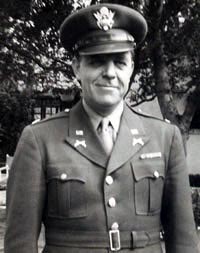
Lewis Byington Ford was a Monterey Peninsula real estate developer. He was a major force in developing Pebble Beach and Carmel Woods. Ford established the Carmel Valley Airport, the first airpark of its kind in the United States, and developed a nearby business district. He created the Carmel Realty Company, was a cartoonist, poloist, baseball player, coach in the Carmel Abalone League, and acted in and directed over 45 plays. Ford was a major part of the social circle and society leader in the Monterey Peninsula.

The Theatre of the Golden Bough was located on Ocean Avenue in Carmel-by-the-Sea, California. This "Golden Bough" was one of two theaters in Carmel's history. It was destroyed by fire on May 19, 1935. Kuster moved his film operation to the older facility on Monte Verde Street, renamed it the Filmarte and it became the first "art house" between Los Angeles and San Francisco. It later became the Golden Bough Playhouse that still exists today.
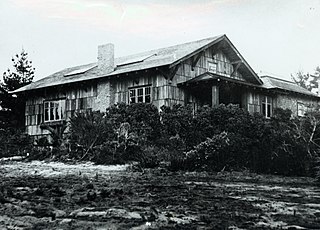
The Carmel Arts and Crafts Club was an art gallery, theatre and clubhouse founded in 1905, by Elsie Allen, a former art instructor for Wellesley College. After using the facilities of various town parks and hotels, in 1907, a clubhouse was built at Monte Verde Street in Carmel-by-the-Sea, California, where the Circle Theatre of the Golden Bough Playhouse is today. The clubhouse served as Carmel's first community cultural center. It held dramatic performances, poetry readings, lectures, and was a summer school for the arts. Between 1919 and 1948 Carmel was the largest art colony on the Pacific coast.

Edward Gerhard Kuster was a musician and attorney from Los Angeles for twenty-one years before coming to Carmel-by-the-Sea, California in 1921. He became involved in theater and establish his own theatre and school. He built the Theatre of the Golden Bough in 1924, and a second theater, the Golden Bough Playhouse in 1952. Kuster directed 85 plays and acted in more than 50 roles in the 35 years he lived in Carmel.

The Carmel Weavers Studio, also known as Cottage of Sweets, is a historic building in Carmel-by-the-Sea, California. It was built in 1922 for Ruth Kuster as a studio, that was in front of the Theatre of the Golden Bough. The studio qualified for inclusion in the city's Downtown Historic District Property Survey, and was registered with the California Register of Historical Resources on January 27, 2003. The building is occupied by the Cottage of Sweets.

The Seven Arts Shop, is a one-story, wood-frame Tudor Storybook retail shop in Carmel-by-the-Sea, California. During the 1930s, the building served as the reading room for the Christian Science organization. It has been designated as a significant commercial building in the city's Downtown Historic District Property Survey, and was recorded with the Department of Parks and Recreation on January 23, 2002. The building is occupied in 2022 by the beauty supply company Body Frenzy.

Sade's is a one-and-one-half-story, commercial building in downtown Carmel-by-the-Sea, California. It was built in 1925, for novelist and dramatist Harry Leon Wilson and his wife Helen MacGowan Cooke as a flower shop and dress shop. In the 1930s, Sade was a former Ziegfeld Follies dancer, made the lower level into a restaurant and bar that was nationally renowned. The building was designated as a significant commercial building in the city's Downtown Historic District Property Survey, and was recorded with the Department of Parks and Recreation on January 28, 2002. The building is currently occupied by shops and restaurants.

Carmel Point also known as the Point and formerly called Point Loeb and Reamer's Point, is an unincorporated community in Monterey County, California, United States. It is a cape located at the southern city limits of Carmel-by-the-Sea and offers views of Carmel Bay, the mouth of Carmel River, and Point Lobos. Carmel Point was one of three major land developments adjacent to the Carmel city limits between 1922 and 1925. The other two were Hatton Fields, 233 acres (94 ha) between the eastern town limit and Highway 1, and Carmel Woods, 125 acres (51 ha) tract on the north side.
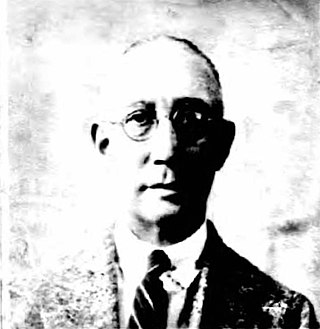
Salmon Fletcher Dutton was an American businessman, Lieutenant colonel in World War I. He is known for constructing the Dutton House, one of the earliest residences on Carmel Point, California. During the 1920s, he was a founding member of the Abalone League.

Ira Mallory Remsen , known locally as Rem Remsen, was an American painter, playwright and Bohemian Club member. He was the son of Dr. Ira Remsen chemist and former president of Johns Hopkins University. Remsen was the author of children's plays notably Inchling and Mr. Blunt, he produced at the Forest Theater in Carmel-by-the-Sea, California in the 1920s. His studio on Dolores Street became the permanent home for the Carmel Art Association in 1933.
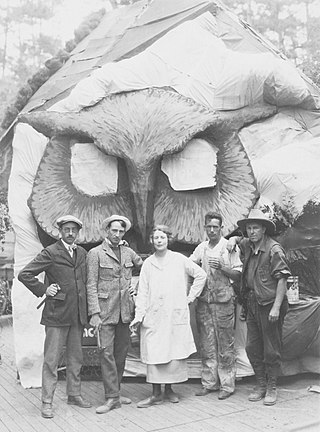
Mr. Bunt is a three-act children's fantasy play by American poet, painter, playwright Ira Mallory Remsen. It was performed in the summer of 1924, at the Forest Theater in Carmel-by-the-Sea, California. Novelist, and playwright John Northern Hilliard played the role of Danny, a circus clown. It was the first time a play was presented at the Forest Theater with its own music composed for it and directed by the composer Frederick Preston Search with his own orchestra.
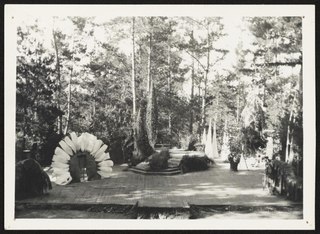
Inchling is a three-act children's fantasy play by American poet, painter, playwright Ira Mallory Remsen. It was performed in the summer of 1922, at the Forest Theater in Carmel-by-the-Sea, California. It was the most popular children's play ever performed at the Forest Theater. It played again in 1928 and 1936 at the same venue. The 1936 revival of Inchling helped overcome an accumulated debt that had taken its toll on the Forest Theater during the Great Depression. The play has been produced by schools and children's theater groups throughout the county, including New York and London.
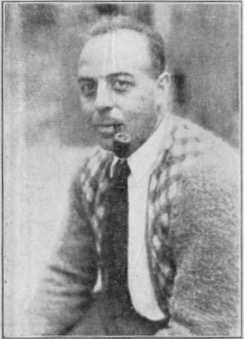
Charles King Van Riper , also known as C. K. Van Riper and Charlie to his friends, was an American newspaperman, writer, and playwright, best known for writing short stories and as the founder of the Abalone League, a baseball league in Carmel-by-the-Sea, California. He went on to build a successful ship-model shop and showroom in Vineyard Haven, Massachusetts.
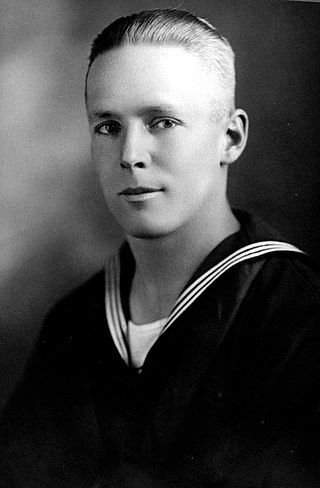
Ernest Seraphin Schweninger was an American actor and grocer in Carmel-by-the-Sea, California. His parents built the Schweninger Building in 1906, known today as the Carmel Bakery. Schweninger was founder and charter member of the Carmel American Legion Post No. 512. He was the owner of the Schweninger's Grocery and first Carmel Bakery on Ocean Avenue. He appeared in many of the early plays at the Forest Theater and Theatre of the Golden Bough. He became a partner and sales manager for the Carmel Land Company that helped develop Hatton Fields, southeast of Carmel-by-the-Sea.

Hatton Fields is an unincorporated community southeast of downtown Carmel-by-the-Sea in Monterey County, California, United States. Homes have views of Carmel Valley, Point Lobos, and Carmel Bay. The residential neighborhood is bordered by Rio Road to the south, Hatton Road to the north, Hatton Canyon to the east, and Junipero Street to the west. The terrain is rolling and naturally landscaped with mature oaks, redwoods, and Monterey Pine trees. Carmel High School, Carmel Mission, and Flanders Mansion are landmarks in this neighborhood. Carmel Mission and Flanders Mansion are two properties that are listed on the National Register of Historic Places. The Mission Trail Nature Preserve runs adjacent to Hatton Fields. Homes are part of the Carmel Unified School District.

Frederick Ritchie Bechdolt was an American journalist, Western fiction writer, and Bohemian member of the Carmel art colony. He was a prolific writer, publishing over 30 books and countless articles in his lifetime.

Lee Gottfried was an American master builder in Carmel-by-the-Sea, California. He had a significant influence on the architecture of the Village of Carmel during his career. Gottfried was one of the main local builders in Carmel and responsible for the first major residential designs done using the local Carmel stone as a building material.

























